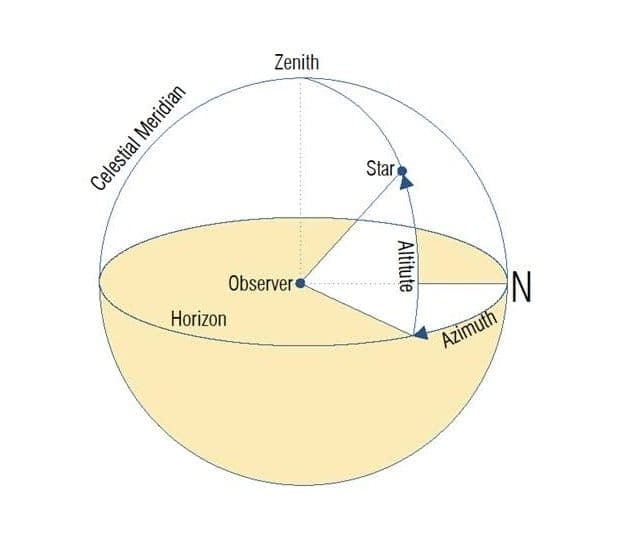
The position of the sun with respect to an observer & object is commonly represented by two angles. These angles are Altitude and Azimuth.
Altitude:
The Altitude comes in, when you know in which direction the object is located and how high in the sky to look for it.
Azimuth:
The angular distance which is usually measured clockwise from the north point of the horizon to the intersection with the horizon of the vertical circle passing through a celestial body.
OR
The cardinal direction in which the object can be found is known as Azimuth. This varies between 0 and 360 degrees. North would be at 0 degrees, east in 90 degrees, and south in 180 degrees, 270 degrees in the west.

Altitude ranges from 0 to 90 degrees, and measures the angle between the horizon, you, and the object. An object with 0 degrees altitude is right on the horizon, while an object at 90 degrees altitude is directly overhead. If you stretch out your arm and make a fist, then your fist covers about 10 degrees on your field of vision, so if the sun is at 40 degrees altitude, it is about 4 outstretched fists above the horizon.
Occasionally, you will see altitudes less than zero, e.g. “At 9:30 PM, the sun will be at -20 degrees altitude.” In this case, the sun would be 20 degrees below the horizon, you would be unable to see it, and it would be night time.
Altitude or height is based on the context in which it is used aviation, geometry, geographical survey, sport, and more.
Here as a Geographical survey, an Altitude is the angular distance of any point of the celestial sphere, measured from the horizon, on the great circle passing through the body and the zenith.
How do you calculate the azimuth and altitude of an object?
For calculation of altitude and azimuth angle, one needs to calculate angular distances. A simple way to do this is to remember that full moon is approximately half a degree in size as seen from the earth; same things happen when you stretch out the hand and give a thumbs up is also a half degree. So, by estimating the numbers of thumbs between the horizon and object one can get a rough estimate of its altitude and azimuth.

Both are measures relative to your position on the earth. They will change with location and time. For example, an object at an altitude of 45 degrees at midnight will not have an altitude of 45 degrees at 3 am (unless you are at the north or South Pole). It will also not have the same altitude at another location in the earth.
These angles are used to design a building space and mass to give a comfortable atmosphere in both exterior and interior. Your building will create shadow according to these angles. If designer has knowledge about it, it is easy for him/her to create shaded space in a garden of the home. Simultaneously, it is also to create massing in building design to give a thermal comfort. To design a climate responsive building design, these are one of the important factors.
By designing a climate responsive home, the user will get the healthy atmosphere.
Also Read:
Know About the Transformation of Building in Architecture!
Know 6 Ordering Architecture Principles of Design!
Importance of Rhythm in Architecture































